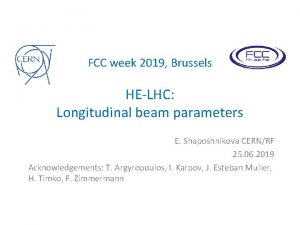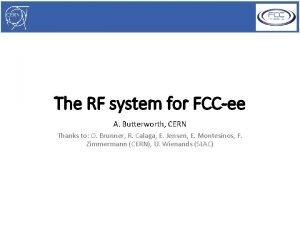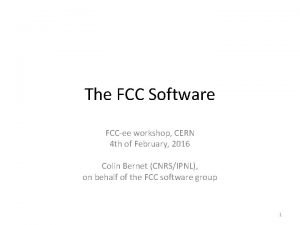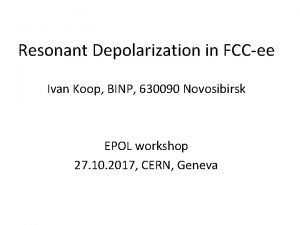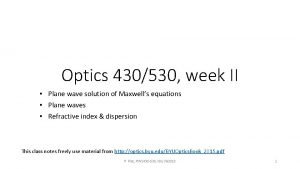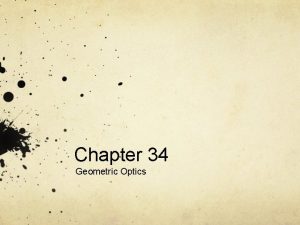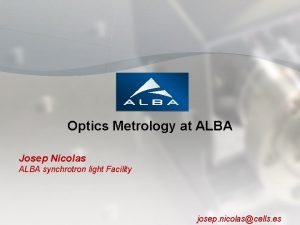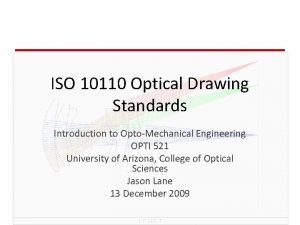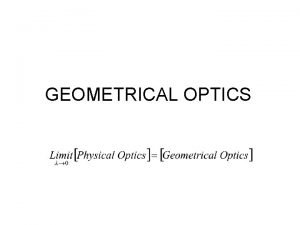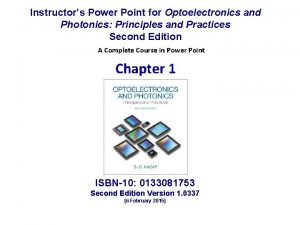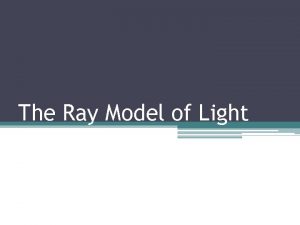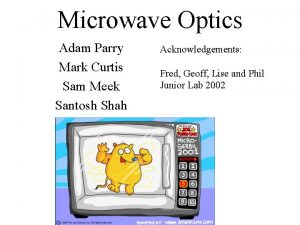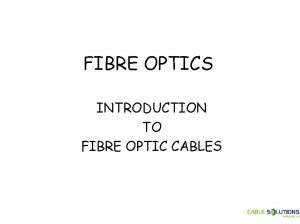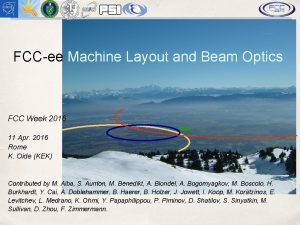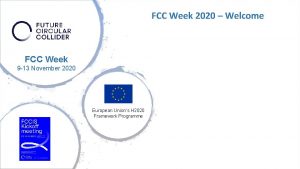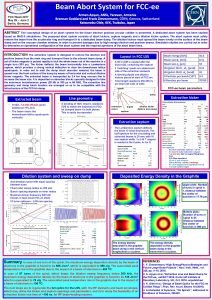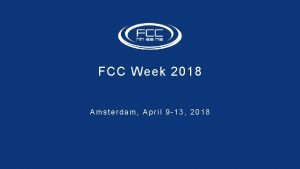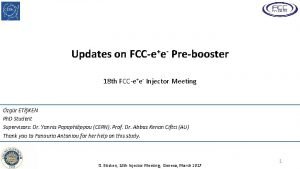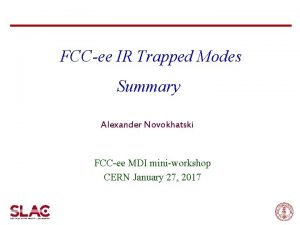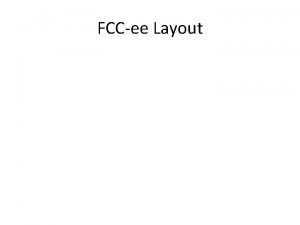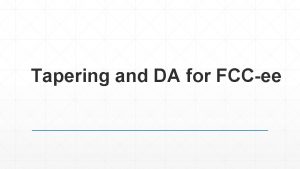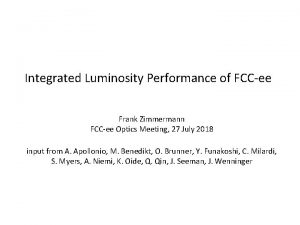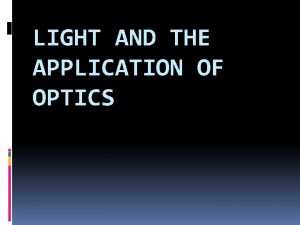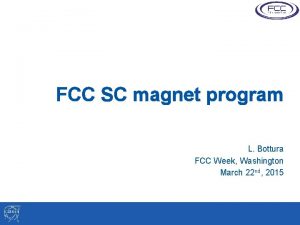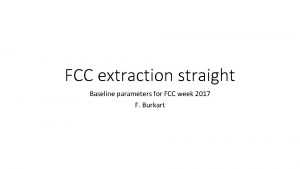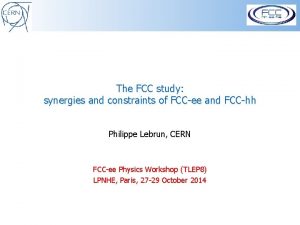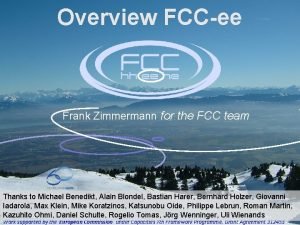FCCee Optics Update April 11 2018 FCC Week






















- Slides: 22

FCC-ee Optics Update April 11, 2018 @ FCC Week 2018 K. Oide on behalf of FCC-ee Collaboration Contributed by M. Aiba, A. Apyan, S. Aumon, E. Belli, M. Benedikt, A. Blondel, A. Bogomyagkov, M. Boscolo, O. Brunner, H. Burkhardt, D. El-Khechen, E. Gianfelice-Wendt, B. Goddard, B. Harer, B. Holzer, P. Janot, R. Kersevan, M. Koratzinos, A. Krasnov, E. Levichev, V. Mertens, M. Migliorati, A. Milanese, D. Mogens, N. Muchnoi, A. Novokhatski, S. Ogur, K. Ohmi, G. Rumolo, D. Shatilov, Y. Papaphilippou, P. Piminov, J. Seeman, S. Sinyatkin, H. Sugimoto, M. Sullivan, T. Tydecks, P. Vobly, J. Wenninger, D. Zhou, F. Zimmermann, M. Zobov Work supported by the European Commission under Capacities 7 th Framework Programme project Eu. CARD--2, grant agreement 312453, and under the Horizon 2020 Programme project CREMLIN, grant agreement 654166.

FCC-ee Baseline Optics 2016 ✤ A baseline optics* for FCC-ee was once established in Oct. 2016 characterized by: ✤ 100 km circumference, 2 IP/ring. ✤ Follow the footprint of FCC-hh, except for around the IPs. ✤ common lattice for all energies, except for the detector solenoid (2 T). ✤ εx ≦ 1. 3 nm @ 175 Ge. V, basically scaling with energy. ✤ ✤ ✤ βx, y* = (1 m, 2 mm) at 175 Ge. V, (0. 5 m, 1 mm) at 45. 6 Ge. V ✤ 90°/90° FODO cell in the arc with non-interleaved sextupole pairs. 30 mrad crossing angle at the IP, with the crab-waist scheme. local chromaticity correction for y-plane, incorporated with crab sextupoles. Suppress the critical energy of SR toward the IP below 100 ke. V at 175 Ge. V, up to 450 m upstream. 100 MW total SR power for all energies. ✤ Tapering of magnets along the ring to compensate the effects of SR on orbit/optics. ✤ Common RF cavities for e+e- at tt. Sufficient dynamic aperture for beamstrahlung and top-up injection. *Phys. Rev. Accel. Beams 19 (2016) no. 11, 111005

Changes by FCC Week 2017 ✤ Motivations for change in 2017*: ✤ Mitigation of the coherent beam-beam instability at Z: ✤ Smaller βx* ✤ 60°/60° cell in the arc, only at Z ✤ Adopt the “Twin Aperture Quadrupole” scheme for arc quadrupoles. ✤ Fit the footprint to a new FCC-hh layout. ❖ The straight sections D&J have been shortened from 4. 2 km to 2. 8 km each. ❖ The circumference has shortened by 2. 2 km. ❖ The location of sections B, F, H, L are slightly changed. *IPAC’ 17, TUOCB 1

Updates after FCC Week 2017 ✤ ✤ ✤ ✤ ✤ Changed the main energy for ttbar from 175 Ge. V to 182. 5 Ge. V. ✤ The SR critical energy to the IP is still kept below 100 ke. V. Pushed the luminosity toward a beamstrahlung(BS)-dominated regime at Z, W, Zh. (→ D. Shatilov’s presentation) ✤ The strong-strong synchrotron-betatron instability is mitigated by smaller βx*. ✤ Smaller βy* for higher luminosity. ✤ Higher bunch charge leads to stronger BS, larger energy spread and bunch length with BS. ✤ Bootstrapping top-up injection is required. ✤ The collective effects still look OK (→ E. Belli). Higher Qs by 60 deg/60 deg arc optics at W for a better polarization measurements. Rearrangement of sextupoles to be compatible both for 60/60 and 90/90 arcs. ✤ Reduction of the field strength of sexts at ttbar. Asymmetric momentum acceptance at ttbar. A combination of 400/800 MHz RF is the baseline at ttbar. Alignment of the arc at 1 m outside of FCC-hh (→ V. Mertens). Special section for an inverse Compton spectrometer (→ N. Muchnoi, A. Blondel). An optics for beam-injection section has been proposed (→ M. Aiba).

Why 365 Ge. V CM for ttbar?

Parameters 2018 (CDR) Z W± Zh tt

Layout of FCC-ee A (IP) 30 mrad FCC-hh/ 13. 4 m 10. 6 m Booster L FCC-hh B 0. 3 m FCC-hh / Booster J (RF) D (RF) FCC-e- FCC-e+ F H V. Mertens G (IP)

Synchrotron radiation toward the IP @ 182. 5 Ge. V Local CCS + crab waist IP Beam uc (ke. V) PSR (k. W) 1470 25. 0 11. 9 596 578 224 4. 0 8. 4 7. 9 1. 5 89. 2 98. 9 0. 28 0. 53 691 1434 742 336 972 … 9. 0 0. 74 10. 7 1. 64 18. 0 … uc < 100 ke. V up to 480 m from the IP @182. 5 Ge. V. yellow boxes: dipole magnets

Optics around the IP ❖ ❖ βx, y* = (15 cm, 0. 8 mm) @ Z βx, y* = (20 cm, 1 mm) @ W IP IP βx, y* = (30 cm, 1 mm) @ Zh βx, y* = (1 m, 1. 6 mm) @ tt IP IP Divide QC 1/2 into 3/2 independent pieces, reversing the polarity at Z, W, Zh. By this split, the chromaticity and the peaks of βx, y around the IP are suppressed even with the reductions of βx, y*.

Field Strength of IP quadrupoles L (m) B’ (T/m) Z W Zh tt QC 1 L 1 1. 2 -78. 60 -96. 16 -99. 98 -100. 00 QC 1 L 2 1 +7. 01 -40. 96 -99. 94 -100. 00 QC 1 L 3 1 +28. 40 +22. 61 +26. 72 -100. 00 QC 2 L 1 1. 25 +2. 29 +40. 09 +23. 75 +58. 81 QC 2 L 2 1. 25 +9. 05 +3. 87 +39. 82 +68. 18 L (m) QC 1 R 1 QC 1 R 2 QC 1 R 3 QC 2 R 1 QC 2 R 2 1 1 1. 25 B’ (T/m) Z W Zh tt -79. 66 +5. 16 +36. 55 +7. 61 +4. 09 -100. 00 -37. 24 +24. 02 +45. 51 +3. 95 -99. 68 -92. 78 +5. 87 +36. 45 +44. 43 -99. 60 -99. 85 -99. 73 +63. 03 +77. 91

Arc cells with non-interleaved sextupole pairs 90°/90° (Zh, tt) 60°/60° (Z, W) (A) D Q D ✤ ✤ (B) D Q S ✤ D ✤ (C) D Q S S D ✤ Due to the non-interleaved scheme of the sextupoles, the location of the sextupoles are somewhat irregular. One super period = 35 FODOs. There are three types of filling sextupoles: (A) no sextupole (B) sextupole singlet for Z and W © sextupole doublet for all energies. At Z and W, the first piece will be powered. The empty space should be filled by dipole magnets for better packing factor. The resulting βs are still very well periodic, while modulations are seen in the horizontal dispersion.

Weaker sextupoles at ttbar ✤ ✤ The maximum field strength at ttbar has been reduced to |B”| < 782 T/m 2 (L = 1. 4 m) to reduce the power consumption. The dynamic aperture is affected by the limit, but still within the criteria.

Asymmetric acceptance (ttbar) E = 182. 5 Ge. V D. Shatilov s. E 0 = 0. 00153, s. E = 0. 00193, Black line: Gauss with s. E = 1. 3 s. E 0 Energy acceptance: 2. 5% = 16. 3 s. E 0 d. E/s. E 0 ✤ The expected energy distribution of the beam has asymmetric tail due to beamstrahlung (D. Shatilov, as above). ✤ Thus the required momentum acceptance should be asymmetric: Wider aperture in the negative side. ✤ The aperture of the positive side can be expressed as the summation of damping and diffusion terms in a half synchrotron period: with the damping rate .

Dynamic Aperture (Z-X plane) ✤ ± 1. 3% ± 1. 7% -2. 8% +2. 4% The dynamic aperture satisfies the requirements by BS and the injection at each energy.

Dynamic Aperture (on-energy, XY plane) ✤ The dynamic aperture is always smaller than the physical aperture given by the beam pipe at QC 1 (15 mm radius).

Effects included in the optimization of dynamic aperture

Inverse Compton Spectrometer for energy calibration ✤ The scattering parameters are estimated from the 2 D distributions of the scattered photons and electrons. ✤ This measurement does not relay on the BPM readings. ✤ Quadrupoles after the dipole are unfavorable. Nickolai Muchnoi

e’ A. Blondel e laser g Require that there is no quadrpole on the trajectory of the outgoing electrons of the lowest energy

Possible Location for the spectrometer B, H ✤ F, L K. Oide Beam Outer Arc Inner Arc IP

Optics with a long straight section after the dipole Previous optics with quads after the dipole B, H (Inner ring) Beam No quads after the dipole for 100 m. The dispersion suppressor dipole (BDS): ; BEND ; BDS =(L =24. 119925292770883 ANGLE =. 002134100603580931 E 1 =. 5 E 2 =. 5 )

An example of optics for injection section (→ M. Aiba) Injection point ✤ Optics for the injection section (B, F, H, L) has been developed by M. Aiba. ✤ If integrated in the collider ring, the effect on the dynamic aperture is tiny and well recoverable by the sextupole optimization.

Summary and next steps ✤ ✤ ✤ Modifications of the beam optics for FCC-ee has been performed after FCC Week 2017: ✤ Energy of ttbar raised to 182. 5 Ge. V. ✤ Smaller β*s for higher luminosity, with sliced final quads. ✤ 60°/60° arc cell at W. ✤ Re-arrangement of sextupoles / weaker sexts at ttbar. ✤ An integration of inverse Compton spectrometer. ✤ Optics for injection section. The resulting dynamic aperture is sufficient for the beamstrahlung and top-up injection. More works are going on: ✤ Full integration of the injection & extraction optics, solenoids, RF section for each energy with the staging scenario, etc. ✤ Low emittance tuning (→ T. Charles) and dynamic aperture with errors and corrections (→ T. Tydecks) as well as beam-beam effects (→ D. El Khechen).
 Difference between ray optics and wave optics
Difference between ray optics and wave optics Venn diagram of geometric optics and physical optics
Venn diagram of geometric optics and physical optics Which is an alternative of log based recovery
Which is an alternative of log based recovery Fcc week 2019
Fcc week 2019 Fccee
Fccee Fccee
Fccee Fccee
Fccee Fccee
Fccee Fidelity quarterly market update q1 2018
Fidelity quarterly market update q1 2018 Gartner magic quadrant bi 2018
Gartner magic quadrant bi 2018 Week by week plans for documenting children's development
Week by week plans for documenting children's development When is healthy eating week 2018
When is healthy eating week 2018 B a f c j e
B a f c j e Optics poynting's theorem
Optics poynting's theorem Divergin
Divergin Nicolas alba
Nicolas alba Iso 10110 optics drawing standards
Iso 10110 optics drawing standards Cardinal refraction
Cardinal refraction Cauchy formula optics
Cauchy formula optics What has historically been the main use for plane mirrors?
What has historically been the main use for plane mirrors? Single slit envelope
Single slit envelope Adam ekt eva
Adam ekt eva Introduction of fibre
Introduction of fibre



